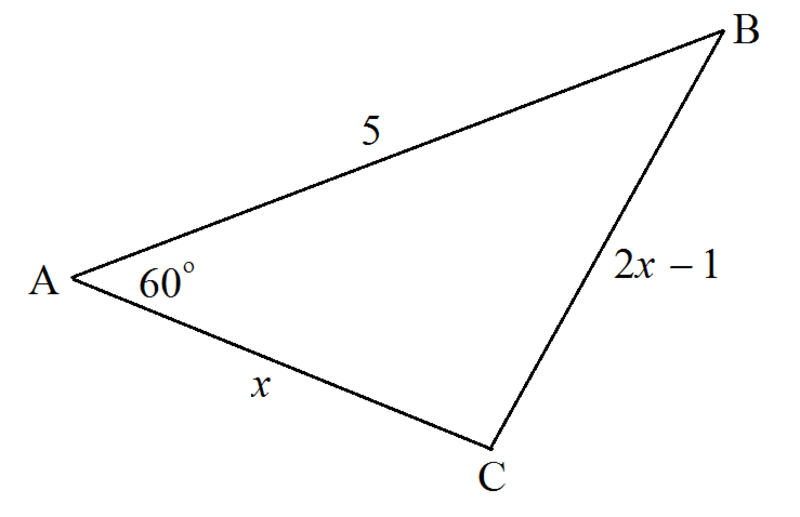An interesting geometry problem I found - 2

Triangle A B C has sides of length 5 , x , and 2 x − 1 . If x is of the form b a , where a and b are positive coprime integers, find a + b .
The answer is 11.
This section requires Javascript.
You are seeing this because something didn't load right. We suggest you, (a) try
refreshing the page, (b) enabling javascript if it is disabled on your browser and,
finally, (c)
loading the
non-javascript version of this page
. We're sorry about the hassle.
1 solution
What you've done there is derive the cosine rule using vectors :-). Using your notation, if you don't substitute values in at the beginning, what you have is a b c = ⟨ A B cos ∠ B A C , A B sin ∠ B A C ⟩ = ⟨ A C , 0 ⟩ = ⟨ A B cos ∠ B A C − A C , A B sin ∠ B A C ⟩
Equating the magnitudes,
B C 2 B C 2 = ( A B cos ∠ B A C − A C ) 2 + A B sin ∠ B A C = A B 2 + A C 2 − 2 A B ⋅ A C cos ∠ B A C
Still, good derivation - if you ever forget the cosine rule in an exam you can still answer the questions!
Log in to reply
Wow! I never thought that I proved the cosine rule like that; I was just focusing on the problem. Lmao. Thanks mate.
According to your assumption, c is not a − b , but b − a .
Log in to reply
@Foolish Learner c has to be a − b because of the half of the parallelogram formed by that triangle's two adjacent sides, A B and B C . Because of orienting A at the origin and A C lying on the x − axis, it has to be a - b. I've written that in the solution.
Bruh I just realised the problem statement got edited. Thanks Chew Seong-Cheong
Nice! Contrived problems are just so... satisfying. :)
Note that this isn't an original problem and there are probably many like it; it was given to me as part of pre-IB advanced maths homework. We are getting taught the cosine rule now, but I solved this problem using vectors before I was taught the cosine rule.
I think this should show why learning vector algebra is very important; if you forget long formulas; you can always use a fundamental concept such as vectors.
Let the vectors that are on the lines A B be a , A C be b , and B C be c .
We can deduce that c = a − b .
Furthermore, we know that the magnitude of vector c is 2 x − 1 .
b = ⟨ x , 0 ⟩ , and the components of vector a can be found using trigonometry:
a = ⟨ 2 5 , 2 5 3 ⟩
Hence,
c = ⟨ 2 5 − x , 2 5 3 ⟩
Equating the magnitudes:
2 x − 1 = ( 2 5 − x ) 2 + ( 2 5 3 ) 2
This reduces to the quadratic equation:
3 x 2 + x − 2 4 = 0
For which a useful value of x = 3 8